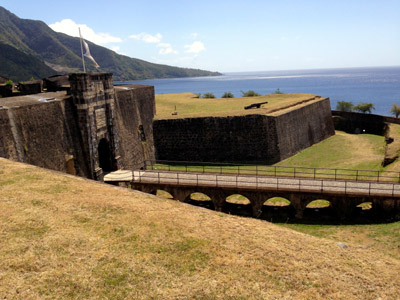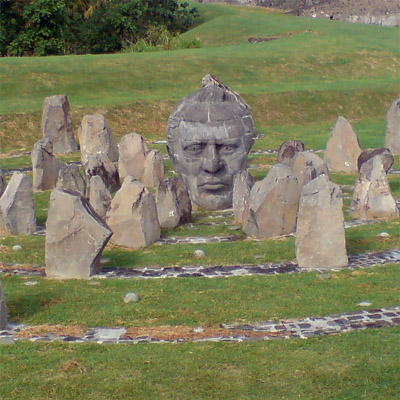 |
Fort Delgrès
Basse-Tere, Guadeloupe
|
|
 |
Constructed:
1650-1770
Used by: France, Great Britain, ex-slaves
Conflicts in which it participated:
Seven Years' War
(1756-1763);
French Revolution (1789-1799)
Also known as:
Fort Saint Charles
Fort Royal
Fort Richepanse
|
Christopher Columbus (1451-1506) was the first European to "discover" the island of Guadeloupe in 1493. 'Twas during this discovery that he also
|
 |
|
|
"discovered" the pineapple, which he called piña de Indias, or pine of the Indians. Spanish settlers followed, who by the 17th century had been ejected by the Caribs, the island's indigenous inhabitants. These feisty folks had done away with Guadeloupe's original inhabitants, the Arawak people, a thousand years previously.
European settlers never permitted themselves to be dissuaded by indigenous peoples for long, however. In 1635, France's Cardinal Richelieu (1585-1642) directed the Compagnie des Îles de l'Amérique, Company of the American Islands, to take Guadeloupe for France, a process that was to include the conversion to Catholicism of whatever Caribs might be accidentally left alive. In 1650 French Governor Charles Houël built Fort Saint Charles at Basse-Terre (founded in 1643) to solidify his Guadeloupean grasp.
|
 The front gate of Fort Delgrès The front gate of Fort Delgrès |
 |
Though the French had subdued the Caribs, they still had the Dutch, Spanish and English to contend with. The British Navy regularly pounded on Fort Saint Charles, conveniently placed as it was for easy bombardment. These frequent attacks necessitated the fort's constant upgrade, and by the start of the Seven Years' War in 1756, Fort Saint Charles was a formidable fortification indeed.
As proved the case on a great many occasions, however, the Royal Navy proved formidable-er. After a huge bombardment on January 23, 1759, the French garrison ran from the fort with its collective arms flailing over its collective head, and the British had themselves a new fort...Which they immediately renamed Fort Royal. |
|
Britain held Guadeloupe until the end of the war, and continued to add forty things to Fort Royal. At the end of the Seven Years' War, part of the Treaty of Paris (1763) stated that France agreed to give up all of its claims in Canada if Great Britain returned tiny Guadeloupe to French control! This seems like a pretty bad trade now, but France's huge territories in Canada were proving difficult both to govern and hold on to, and Guadeloupe was a hugely prosperous little colony, easily controlled by its colonial masters.
Shortly after the French Revolution got underway in 1789, slavery was abolished in all of France and its colonial lands. This no doubt seemed swell to all of those non-slaveholding French folks in France, but the wealthy planters on Guadeloupe were wealthy due to slavery...plus they were monarchists, who thought this whole French Republic business was absolutely ridiculous anyway. These merry slaveholding monarchists declared independence from France in 1791.
|
A a widespread slave revolt in 1794 caused Guadeloupe's erstwhile authorities to take the bold step of asking Great Britain to save them by occupying the island. Why sure said Great Britain, and Guadeloupe's new bosses moved in in April of 1794. Rogue French colonial administrator Victor Hughes (1762-1826) led a small army against the British, and by December of 1794 had booted them off the island and freed the slaves...who then turned, perhaps predictably, on their masters. Guadeloupe was now governed by its ex-slaves.
Napoleon (1769-1821), however, wanted Guadeloupe back. The Emperor sent an expeditionary force under Antoine Richepanse (1770-1802) to Guadeloupe in 1801, which got to work on the forces resisting the French, led by Louis Delgrès (1766-1802).
|
 |

A weird monument to, one assumes, Louis Delgrès. |
|
By May of 1802, Delgrès and his men had taken the fort of our current interest, by now renamed Fort Saint Charles, from colonial troops...and the irresistible French expeditionary force was approaching. Delgrès and around 400 of his troops left the fort to the French (who renamed it, again, to the particularly unmanly-sounding Fort Richepanse) and was soon chased down. Louis Delgrès detonated his force's gunpowder stores on May 28, 1802, hoping to take lots of French troops with him. Heroic! Let's name a fort after this guy! |
| Careful, it's in French, and you're guaranteed to do some squinting in trying to figure out the color coding scheme. But still! |
 |
Fort Richepanse was officially decommissioned on August 23, 1904. It was classified as a national monument in 1977, and thank GOD, was divested of its ridiculously effeminate name in 1989. Today known as Fort Delgrès, it is open for self-tours during the week, but show up on a Friday and you'll have the vast wisdom of an official guide imparted upon you.
|
|
|
|
|
|
|
|
 |




